Home
Aussie Bee Online
Welcome
New Articles
About Native Bees
Bee Photo Gallery
Bees in Your Area
Common Questions
Rescuing Native Bees
Exotic Bumblebees
What are Stingless Bees?
Buying Stingless Bees
Honey Production
Crop Pollination
Study Native Bees
Field Guide
Information Booklets
Tim Heard's Book
John Klumpp's Book
Aussie Bee Back Issues
Seminars
Links
Support Native Bees
Aussie Bee Shop
Order Form
Who We Are
Donations
Privacy Policy
Free Newsletter
Website Survey
Download Printer-Friendly PDF version of this article
Australia's Biggest Ever
Native Bee Workshop
Dr Anne Dollin
Australian Native Bee Research Centre
October 2007
Fifty one native bee enthusiasts and ten presenters descended on the University of Western Sydney - Hawkesbury on 14-15 October 2006 for Australia’s biggest ever native bee workshop! They came from six states and territories of Australia with hives, photographs and ingenious hive equipment for two days of seminars, practicals and lively discussions about Australia’s more than 1500 native bee species.
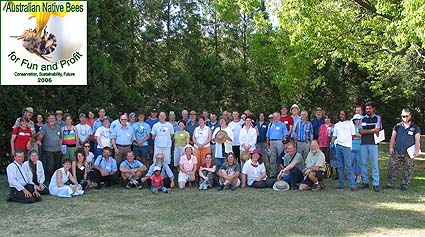 |
| Presenters and participants at the ‘Australian Native Bees for Fun and Profit’ workshop, University of Western Sydney, October 2006 |
The participants were warmly welcomed by Professor Robert Spooner-Hart, Director of the Centre for Plant and Food Science, University of Western Sydney - Hawkesbury.
Then Dr Michael Batley delighted the audience with his presentation entitled, ‘There are Bees at the Bottom of my Garden’. Michael played his magnifi-cent DVD footage showing the beauty and diversity of the native bees living in his local Lane Cove National Park area. These included bees popping their heads up from burrows in the local playground, brilliantly coloured cuckoo bees roosting on stems, leafcutter bees snipping pieces of leaf for their nests and a stingless bee nest in an old turpentine tree.
Michael explained that of our 1647 described Australian species, only about 5 to 10% may specialise in pollination is some way. We need to protect the full diversity of our native bee species to ensure we can meet Australia’s future pollination requirements.
Dr Tish Silberbauer of Macquarie University explained how to enhance nesting and foraging opportunities for native bees in our suburbs and gardens. Tish described the wide range of nest sites used by our native bees, such as earthen banks, dead branches, stems and cavities.
Tish urged the workshop participants to:
• get to know their local native bees by watching for flower visitors;
• try to locate local nest sites;
• encourage neighbours and the local council to protect native bee populations;
• avoid using toxic chemicals that may harm the bees; and
• try not to keep the garden too tidy because bees need dead stalks and old hollow trees for nesting sites.
 |
| Workshop presenters (from left): Michael Batley, Katja Hogendoorn, Martyn Robinson, Megan Halcroft, Les Dollin, Mark Greco, Anne Dollin, Tish Silberbauer and Russell Zabel |
Dr Anne Dollin of Aussie Bee took the audience on a tour of stingless bees from around the world to deep inside the nest. The earliest archaeological records of stingless beekeeping come from the Maya people of Mexico over 2000 years ago. Today stingless beekeeping is practiced in many areas of the world such as Mexico, Honduras, Brazil, Africa and Asia. In Australia, stingless beekeeping is rapidly gaining popularity with enthusiasts working on nest rescues, honey and cerumen harvesting and crop pollination. Anne then reviewed the nest structures and behaviour of these unique bees.
In the next session, expert beekeepers, Russell and Janine Zabel, demonstrated the art of boxing stingless bee nests. The Zabels had travelled down all the way from Queensland with a large collection of demonstration nests to contribute to our workshop. The audience was fascinated to see the queen bee in one of the nests that Russell opened and to see his tried and true techniques for boxing both Trigona and Austroplebeia stingless bees. Russell and Janine’s demonstration provided an excellent chance for participants to get a first hand look at the intricate structures inside stingless bee nests. A taste of tangy stingless bee honey fresh from the nest was an added bonus for the group!
| Russell and Janine Zabel split open a Trigona log nest during their demonstration at the workshop |
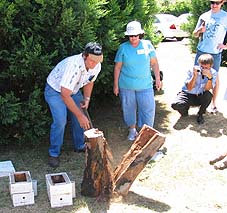 |
In the afternoon, Anne Dollin explored the challenges of keeping stingless bees in Sydney. The climate of SE Queensland is ideal for stingless bees. However, in Sydney, heatwaves and extremely cold days can kill hives. Furthermore for five months of the year it may not be warm enough for the bees to forage and hives may become weak. This is why stingless bees are not naturally found in areas colder than Sydney, such as Katoomba, SW NSW or Victoria. Nests still in their original logs survive better than those in standard boxes. However, creative beekeepers are actively developing new hive designs with heaters and improved insulation to tackle these climate issues.
Megan Halcroft of the University of Western Sydney then gave a report on her research into the effect of African Small Hive Beetles on Austroplebeia stingless bees. Despite the fact that these bees store relatively little resin in their nests, the bees still displayed an impressive ability to defend themselves against these foreign beetle pests by burying them in resin. Read more.
Parallel practical sessions followed. Russell and Janine Zabel demonstrated their efficient techniques for splitting a hive of Trigona stingless bees. Then Anne Dollin displayed an array of hive equipment: eight different box designs by Queensland beekeepers, and honey feeders, predator traps and hive tools.
The first day’s program concluded with a fascinating talk by Dr Katja Hogendoorn who had flown from the University of Adelaide to be part of the workshop. Katja spoke about the secret lives of native bees: ‘The Days of our Hives!’
Social behaviour amongst our Australian native bees is relatively rare. Other than our stingless bees, only the carpenter bees, the reed bees, some halictid bees and one masked bee display some social behaviour. The masked bee, Amphylaeus morosus, lives in tree fern fronds. Two or three sister bees stay in the nest in spring and cooperate to make cell linings, guard the nest and forage. Katja had also studied the social lives of carpenter bees in Israel that are quite similar to our Australian carpenter bees. The mother bee guards the nest burrow while her daughters lay the eggs in the nest. Katja showed the perspex-topped balsa wood observation hives she had used to study the secret lives of the carpenter bees.
Day 2: 15th October 2006
Katja Hogendoorn kicked off the second day with a thought provoking look at the role of native bees in crop pollination. She said that 75% of crop plants rely on pollination by animals. 11% of this pollination is done by managed bees such as honeybees but 50% is done by unmanaged bees.
• Managed bees: Apis honeybees are the most widely used managed bees overseas but carpenter bees, mason bees, alkali bees and leafcutters are also used. In Australia almost all crop pollination is done by honeybees with some use of stingless bees and leafcutters.
• Unmanaged bees: There are 30,000 species of unmanaged bees worldwide, varying widely in their size, nest systems, flower preferences, pollen collecting techniques and flying season. These are a very poorly used resource.
Katja went on to describe some crop pollination opportunities in Australia with carpenter bees and halictine bees. Then she described her research on the use of blue banded bees for greenhouse tomato pollination.
Early trials showed that the blue banded bees could produce larger yields and heavier tomatoes than the wand pollination technique being used in Australia today. Studies are now in progress with commercial scale greenhouses. It is hoped that, with this technology, Australia can avoid importing European bumblebees for greenhouse tomato pollination since these exotic bees could threaten the Australian environment and cause serious weed spread.
Mark Greco of the University of Western Sydney then explained the advantages and challenges of using stingless bees for crop pollination. In Australia stingless bees have been successfully used for pollinating crops of macadamia, avocado, lychee and watermelon. Mark studied the use of Trigona and Austroplebeia stingless bees with greenhouse capsicum crops. Mark found that overall the Trigona bees increased the yield by 24% while the Austroplebeia increased it by 18%. However, in one of the trials, the Austroplebeia bees actually caused a small decrease in yield. The reason seemed to lie in the different foraging techniques of these bees and the importance of having the right number of bees per plant in the greenhouse.
Mark also showed some of his amazing CT scans revealing the detailed structure inside stingless bee hives. Mark’s revolutionary technique allows him to monitor accurately the growth of hive structures, brood, and honey and pollen stores without damaging the hive by opening it up. This technique can also be used to show the complex burrows and cells inside a nest block used by blue banded bees. Even individual stingless bees can be studied using micro CT scans, revealing their internal anatomy such as the honey stomach and air sacs.
In the following practical session, a number of beekeepers displayed their creative hive designs:
• Mark Greco showed his design for an insulated hive including a honey super box and an inbuilt feeding station. Insulation is provided by an airspace between an outer and an inner box and by a series of air tubes through the walls. The box is lightweight, sturdy and cheap to build. Mark also demonstrated Dr Tim Heard’s technique of native bee honey harvesting using a hive super full of honey and a special honeypot piercing tool, both of which Tim had kindly contributed to the workshop.
| Workshop organiser, Mark Greco, guides participants harvesting honey from a full hive super box using Tim Heard’s method | 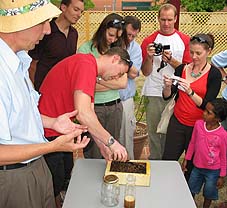 |
• John Klumpp showed his innovative tubular hive design (which he has dubbed the Klumppy’s Insulated Tubular Hive or KITH) made from foam filled PVC pipe. Air tubes passing through the insulated walls of this hive, from the base board up to an airspace under the lid, allow air circulation around the nest. John’s beautifully made hive heater, using 12V car light bulbs as a heat source, can be clipped underneath his hives. John also displayed his shadecloth hive awning and his clever honey feeder that excludes honeybees and other insects.
| John Klumpp points out features of his KITH hive design to workshop participants | 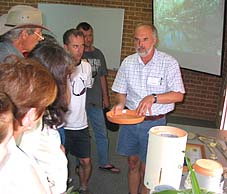 |
• Robert Luttrell has been doing some sophisticated temperature tracking with his hives and presented some fascinating graphs showing the performance of various hive designs under a range of ambient temperatures. Robert has found that natural logs have particularly good insulation properties for stingless bee nests. Robert displayed his tubular hive design, made from sections of terracotta pipe, polystyrene and fibreglass, that he hopes will provide insulation benefits for his bees similar to those of a log.
| Robert Luttrell with his temperature graphs and tubular hives | 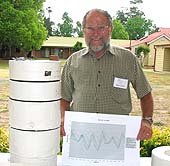 |
• Carlos Alonso brought his ‘Coolgardie Solar Hive’ to show to participants. His design is based on the old Coolgardie Safe that was used by our pioneers to keep food cool prior to ice boxes and refrigerators. Carlos wanted to prevent the catastrophic overheating of stingless bee hives that can occur during heatwave conditions. In Carlos’ inventive design, the bees are housed in a modified esky inside a large polystyrene box. Water evaporates from a wet cloth panel to cool the air inside the polystyrene box. Air flow inside the box is provided by a small computer fan which is powered by a solar panel.
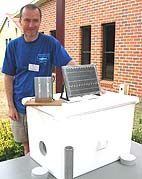 |
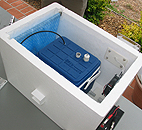 |
| Left: Carlos Alonso with his Coolgardie Solar Hive; Right: Interior of Carlos’ hive. | |
• Alan Ashhurst displayed two hives fitted with insulating polystyrene covers. Alan is working in cooperation with Ku-ring-gai Council on a project placing stingless bee hives with local residents. Following hive losses in winter 2003 and during the heatwave on New Years Day 2006, Alan has become very interested in optimising an insulated hive for Sydney’s climate. He has done a series of studies using digital thermometers comparing the performance of hives fitted with polycovers or painted with special insulating paints.
| Alan Ashhurst with his insulated hives | 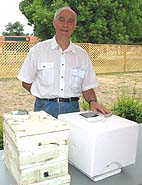 |
In the next presentation of the workshop, Martyn Robinson of the Australian Museum gave tips and techniques for caring for reed bees (Exoneura) based on many years of observation and experimentation.
Martyn explained a surprising number of ways that you can assist, feed and rescue the tiny native reed bees that sometimes live in dead lantana canes. Sections of lantana cane (30 cm long) containing reed bee nests can be cut out and relocated to shrubs in a safe garden. The entrances generally are best facing downwards and poking out of the foliage. To deter ants, smear a ring of vaseline around the stem to which the reed bee nest is attached.
A lost reed bee can be fed in a jar with a paste of Apis honey and health food shop pollen. Slightly enlarge the nozzle of a 5 ml syringe. Then chill the bee briefly in a fridge and transfer it into the syringe. Once the bee has warmed up again it can be gently driven into a nest entrance using the syringe plunger.
In the final practical session of the workshop, Les Dollin showed participants how to make mud nests for blue banded bees using short lengths of rectangular PVC downpipe. Shallow starter holes are pressed into the drying mud with a biro to encourage the bees to use the nests. Anne Dollin and Megan Halcroft also showed methods of making artificial nests for resin bees. Simple nests can be made by drilling holes (150 mm deep) into blocks of timber. These nests are cheap and easy to make and are ideal for seeing what species of resin bees may be in an area. More elaborate nests can be made by cutting grooves in the surface of a timber block using a router tool, then adding another layer of timber on top. These nests have the advantage that they can be opened up once the nest is finished to see the completed nest cells inside. Each participant received a completed blue banded bee mud nest and a drilled resin bee timber block to take home.
Australia’s biggest ever native bee workshop was greatly enjoyed by both participants and presenters. It provided a unique opportunity for everyone to learn more about native bees and to meet other native bee enthusiasts. A warm thank you goes to everyone who contributed to the weekend, to workshop organiser, Mark Greco, and to the University of Western Sydney - Hawkesbury for hosting this special native bee event.
• Download the PDF version of this article.
(If you have not used PDF before, click here.)
• For more interesting Aussie Bee Online articles on native bees, visit the contents
Author: Anne Dollin
(See Anne Dollin's Google+ profile)
|
Please feel free to print out this article or to email copies of the PDF version to your friends. This article may also be reproduced or hosted on other websites providing it is kept in its full and unaltered form including ANBRC contact details.
|
Search Aussie Bee Website:
© 1997-2018 Australian Native Bee Research Centre
PO Box 74, North Richmond NSW 2754, Australia